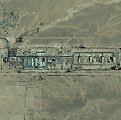
The Scotsman August 13, 2002
NERVE GAS PLANTS DORMANT BUT DEADLY
By Tim Ripley
 Fallujah I, CW Plant, Iraq |
The site, named Fallujah I, some 38 miles north-west of Baghdad, is one of three similar facilities built in the late 1980s around the town of Habbaniyah to mass-produce elements, known as precursors, of the nerve gases used in the Iran-Iraq war and against the Kurds in 1988 and 1991.
Images taken by an American company, DigitalGlobe, and published yesterday by the Washington-based "think tank", globalsecurity.org, clearly show that the plant has been rebuilt. Piles of rubble left after air strikes by US warplanes during the 1991 Gulf war have been bulldozed to the side of the 68-acre site. Although the photographs would appear to support claims by hawks in Washington and London that the Iraqis have been able to rebuild their nerve gas arsenal, the images show huge storage bunkers around the site to be empty. There is little evidence of recent activity, such as tracks from trucks or forklift, to indicate that Iraq is trying to build up a stock-pile of chemical weapons.
The hot Middle East climate means that Iraqi chemical weapons are only effective for a few days after production before dissipating, so Baghdad would be unable to store them for long periods. The Iraqis would have to ship them directly to the front lines from factories for combat use.
Heavy activity at sites like Fallujah would be a key indicator that Iraq was making preparations for chemical warfare.
Fallujah was once part of the Iraqi nerve gas production chain, with the precursors being produced there before shipment to the Muthanna state establishment north of Baghdad for final production and insertion into artillery shells or aircraft bombs.
In 1994, Iraq told UN inspectors that it wanted to convert Fallujah I into a plant for the civilian production of "general and fine" chemicals. Production would be at a rate of several hundred to some thousand tonnes per year, the Iraqis claimed.
At the time the UN said this was reasonable and the site was monitored by inspectors, after equipment used for nerve gas production was removed and destroyed.
Since December 1998, when the inspectors left, the Iraqis have been able to do what they want at the plant, away from the prying eyes of the outside world. It would, for example, have been possible to make vital conversions ready to allow precursor production to be ramped up at very short notice.
The pictures highlight the dilemma faced by Washington and London over the return of United Nations inspectors. From orbit there is little to differentiate an ordinary chemical plant from a nerve gas factory.
Only close inspection inside buildings will be able to prove if sites such as Fallujah have reverted to nefarious use.
Still, for now, the US and Britain appear to be set against the return of inspectors.
Copyright 2002 The Scotsman Publications Ltd.

